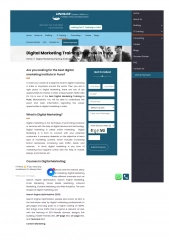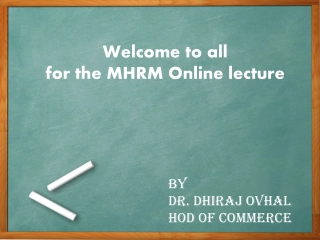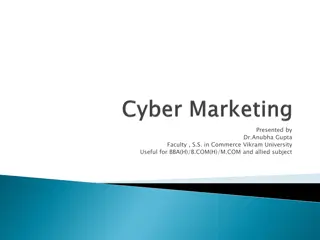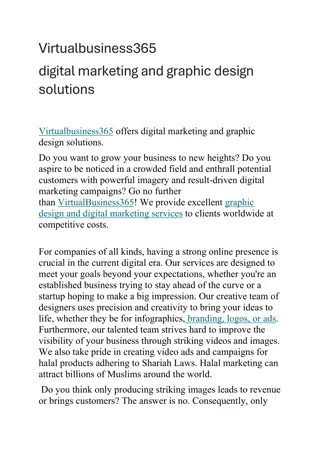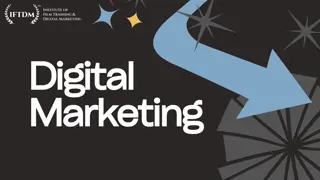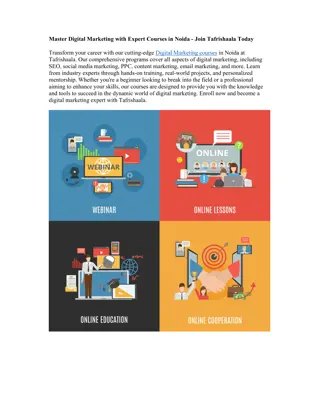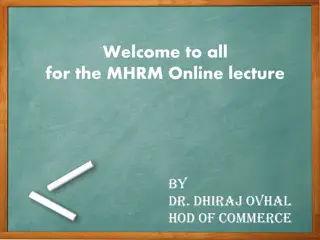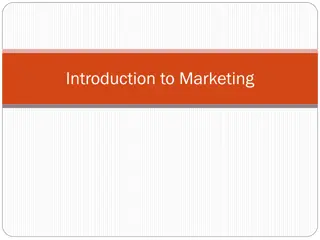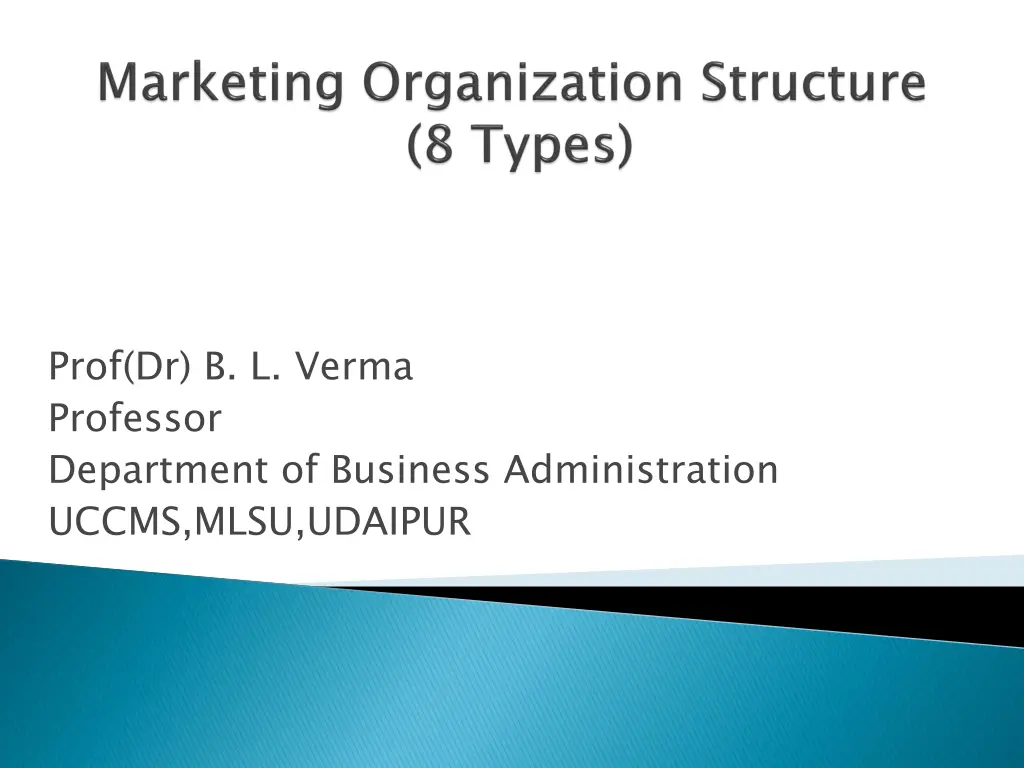
Types of Organizational Structures: Line vs. Functional
Explore the difference between line organization and functional organization in business administration. Line organization follows a top-down hierarchy, while functional organization groups tasks based on functions in departments. Learn about the merits and demerits of each structure.
Uploaded on | 3 Views
Download Presentation

Please find below an Image/Link to download the presentation.
The content on the website is provided AS IS for your information and personal use only. It may not be sold, licensed, or shared on other websites without obtaining consent from the author. If you encounter any issues during the download, it is possible that the publisher has removed the file from their server.
You are allowed to download the files provided on this website for personal or commercial use, subject to the condition that they are used lawfully. All files are the property of their respective owners.
The content on the website is provided AS IS for your information and personal use only. It may not be sold, licensed, or shared on other websites without obtaining consent from the author.
E N D
Presentation Transcript
Prof(Dr) B. L. Verma Professor Department of Business Administration UCCMS,MLSU,UDAIPUR
1. Military Type of Organisation 1. Military Type of Organisation: :
This is the simplest and oldest form of organisation. It is also referred as line organisation, scalar or hierarchical organisation. Under this type of organisation, a superior delegate s authority to a subordinate, who in turn delegates authority to another subordinate and so on. Authority descends from the top to the bottom level, through downward delegation of authority. Subordinates become responsible to their immediate superiors. The topmost management has full control over the entire field.
This form is suitable: 1. If the business is comparatively small. This form is suitable:
2. If the labor management problems are easy to solve
3. If the processes are easily directed. 4. If the work is of a routine nature.
Merits: 1. It is simple to work. 2. It is economical and effective 3. It is easy to fix responsibility. 4. It facilitates quick decisions and prompt actions. 5. Quick communication is easy. : 6. Discipline can easily be maintained
Demerits: 1. The organisation is rigid and inflexible. 2. It works on a dictatorial basis. 3. Departmental heads act on their own whims and desire, as it is difficult to secure coordination of the activities of workers and departments. 4. In big business it does not operate satisfactorily.
2 2. Functional Type The limitations of line organisation have been removed under this system. . Functional Type Organisation Organisation: : All types of work of the organisation are grouped and managed by the top executive. There are separate functional departments for major functions of the enterprise; example personnel department, purchase department etc. Each department does its function for the entire organisation. Sales department does the function for the whole enterprise. The functional organisation works through the line organisation. Functional organisation is based on expert knowledge and makes the greatest use of division of labour resulting in high efficiency and specialization.
Merits: 1. Greatest use of division of labour is possible. Merits: 2. The system is based on expert knowledge. 3. Functional efficiency of the worker can be maintained. 4. Mass production is made by standardization and specialization. 5. Separation of mental and manual functions is possible. 6. Methods and operations can be standardized.
Demerits: 1. Too many experts and bosses (high officials) create confusion in the mind of the worker. Demerits: 2. It is difficult to fix responsibility on workers.
3. Discipline and morale of the workers are seriously affected, because of contradictory orders from different experts. 4. There is heavy overhead expense.
3. Line and Staff System: In this type, the organisation is based on the line organisation and the functional experts advise the line officers as to the functions of the enterprise. The line officers are the executives and the staff officers are their advisers. 3. Line and Staff System: Though the staff officers do not have the power to command the line officers, their advice is generally adhered to.
The combination of organisation with this expert staff forms the type of organisation-line and staff. The line keeps the discipline and the staff provides expert information. The line gets out the production and the staff carries on research, planning, fixing standard etc. This type of organisation is suitable for large concerns. The line officers give orders, decisions etc., to subordinates in consultation or guidance with the staff officers. The underlying idea of this method is that specialized work is to be left to experts who will give advice on specialized groups-investigation, research etc. The staff officers who have no executive positions in the concern, but are only the thinkers, while the line officers are the doers.
Merits: 1. This type is based on specialization. 2 It brings expert knowledge of the whole concern. 3. Increased efficiency of operations may be possible 4. Mass production is possible. Merits: Demerits: 1. There arises confusion unless the duties and responsibilities are clearly indicated by charts and office manuals. 2 Advice and, expert information are given to the workers through the line officers. It is possible that the workers may misunderstand or misinterpret. Demerits:
4 4. Committee Committee organisation is widely used for the purpose of discharging advisory functions of the management. Committees are formed in different levels of organisation. A committee is a group of people who meet by plan to discuss or make a decision on a particular subject. Because of its advantages, committee organisation is preferred. The management committee usually consists of General Manager and departmental heads to deal with current problems. A co-ordinated plan is agreed to in a meeting. Thus group judgement is possible to attain an aimed result. . Committee Organisation Organisation: :
For a successful committee noted For a successful committee organisation noted: : organisation, the following hints may be , the following hints may be 1. Number of individuals is to be kept at a minimum, so as to function effectively. If there are many members, it will cause lengthy discussions and delayed decisions. 2. The chairman of the committee must have full control over the members, while they are in meeting. 3. There must be a proper agenda, arranged in order of importance. 4. All the members are to be informed before the meeting about the points to be discussed, so that they may prepare for the meeting. 5. The meeting must be started on time and must end on time.
Merits: 1. It stimulates co-operative action. Merits: 2. It can promote better understanding. 3. A problem is discussed in detail and decision taken. 4. It facilitates co-ordination of activities of various departments. 5. Group discussion and decision will bring better results. 6. It gives demographic management.
Demerits: 1. Committees are expensive. 2. Committee weakens individual responsibility. 3. Committee may sometimes become time-consuming rather than time- saving. 4. Responsibility cannot be fixed on any person. 5. It lacks secrecy. Demerits:
5. Geographical Type: The structure is based on territorial or regional basis. When business activities are expanded, the various parts of the market area are divided into territories. The whole world into continents, continent into regions, region into zones, zone into districts etc. This type of organisation gives importance to the consumer s needs and desire, especially in pharmaceutical companies. In this way, the market is fragmented into different sales territories like national market into regions, region into districts, district into areas as shown in the chart next. Salesmen are controlled by the respective district sales managers (DSM), DSM are controlled by their regional sales manager (RSM), RSM are controlled by the marketing executive 5. Geographical Type:
This type of organisation enjoys the knowledge of likes and dislikes of people in the particular areas. A firm can modify or alter the products, on the basis of the needs of the buyers who are represented by sales manager. The competitors can be counteracted soon.
Merits (Geographical Type): 1.Geographical type of divisions allow a manager to pay special attention to the needs and problems of the local markets. Merits (Geographical Type): 2. Geographic type of organisation provide opportunities for local talent to be utilized. 3. Geographic division helps managers gain extensive knowledge of diverse activities. 4. This type of organisation improve an organization s relationship with customers.
Demerits 1.This type of organisation require more people to work. Demerits (Geographical Type): (Geographical Type): 2. There arise communication problems. 3. Cost of operations are high. 4. Top managers at HO find it difficult to control and supervise the activities in different locations.
6. Product Type: Certain companies produce different varieties of products and it is advantageous to boost the sales on the basis of product or product groups. A separate product manager is appointed for each product. He attends to the production and marketing of his products when the market is competitive, the product type organisation with the product manager can concentrate its attention on the performance of a particular product or brand. Sales promotion, advertising, marketing research etc., remain as the centralized activity for the product group. 6. Product Type:
7 7. Market Type (Consumer): This type of organisation is based on the different types of customers. The enterprises have adopted customer-oriented marketing and thus there arise two sets of organisations through which the needs of customers or market are met; i.e., subdivision of markets on the basis of government and non- government customers, industrial individual customers, rich and poor customers and on the basis of sex, income, taste, age etc. . Market Type (Consumer): A firm may have different groups of customers, who have different needs and problems. Thus, each section can look into the needs of each group of consumers and facilitate their buying-wholesale section, retail section etc.
Merits (Consumer type): 1. This type of organisation can encourage consumers with clearly defined services. Merits (Consumer type): 2. The specialists can understand the needs of a particular segment of customers. 3. This type of organisation is useful to serve different type of customers. Demerits (Consumer type Demerits (Consumer type): ): 1. Coordination between sales and other functions of marketing is difficult. 2 More man-power is required thus expenditure is high.
8 8. Matrix Type: Matrix organisation is also known as grid or project organisation. Matrix organisation is created by merging the two or more complementary organisations, say, purchase section and sales section. A team may be set up within the existing organisation, to conduct a study of a particular product or design or to complete a specific assignment in time. . Matrix Type: A project manager has a project team consisting of people from several functional sections. For instance, a project team is formed to market the television, and for this people will be drawn from different functional departments, say, production, research, marketing, engineering etc.
These specialists are drawn from respective departments, borrowed to perform their part in the project work. When the project work is complete, they go back to their respective departments. This type of organisation is needed when a special type or urgent assignment of jobs or complicated job or a new product etc., is introduced. Generally, such organisation may be temporary.
Merits: 1. Specialized product knowledge is acquired. Z It is economical to draw experts from various sections. 3. Expansion, improvements, diversification etc., are the result. 4. The chances of success of the project are higher. 5. It allows effective use of resources Merits:
Demerits Demerits (Matrix type (Matrix type): ): 1. Administrative costs are high. 2. Workers under this type have to report to two bosses. 3. There arise conflicts between functional managers and project managers.
We may adopt any of the organisation structures for organizing its marketing operations; it should be goal-oriented and flexible. It must have scope for possible future growth. Market conditions change very frequently. Marketing structure should be capable of accommodating all the changes and marketing people should be dynamic to take up various sales job assignments and marketing challenges. The adopted marketing organisation structures should provide for the formulation of marketing policies and programmes from the bottom to the top and every marketing person should have an opportunity for participation in it.





